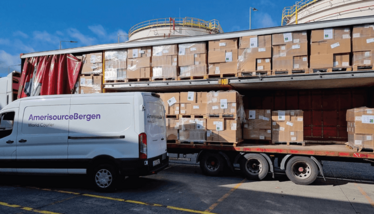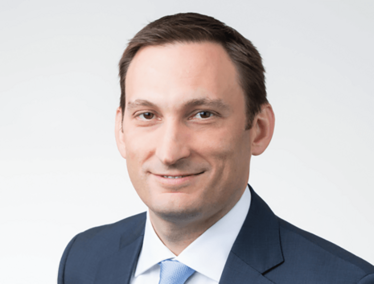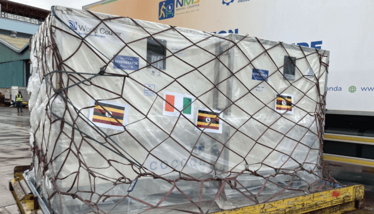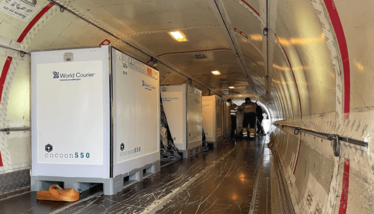
Desert, Tundra, and Archipelago: a Vaccine Epic
A behind-the-scenes perspective on the global COVID-19 vaccine rollout. What did the industry learn – and how will it ensure nobody gets left behind?

Prepare to march into the logistical maze of delivering COVID-19 vaccines worldwide. Here, Doug Cook (EVP & President, Business Group – Global at AmerisourceBergen) and Juan Guerra (SVP & Managing Director of Alliance Healthcare, a leading wholesaler of healthcare products in Europe which AmerisourceBergen acquired in 2021) explain the challenges of vaccine distribution and review the lessons learned.

Doug Cook
Before the rollout of COVID-19 vaccines began, how were you and your partners preparing?
Cook: As vaccine candidates moved through development, we began working with partners across the supply chain (and around the world) to build logistics strategies that would enable the secure and reliable distribution of vaccines as soon as they became available. We leveraged our logistical expertise and distribution capabilities to create plans that would support the strict temperature-sensitive requirements and immense scale, and also account for country-specific challenges, such as limited infrastructure. Each instance required thorough route planning, robust contingency plans, and temperature-controlled packaging and storage solutions to protect product integrity from the moment of exit from the manufacturer’s facility all the way through to the point of administration.
For example, to prepare for deliveries across Canada’s vast geography, Innomar Strategies – a part of AmerisourceBergen – and FedEx Express Canada conducted several dry runs in December 2020. Innomar and FedEx, which were selected by the Government of Canada to support vaccine distribution (1), sent empty boxes to the manufacturer’s facility in Europe and tracked the journey of those boxes back to Canada. Once the shipments arrived in Canada, Innomar and FedEx tracked the boxes all the way to remote communities in the Northwest Territories. Based on the lessons learned from that trial run, the companies’ teams added a second GPS tracker to build in redundancy and maintain product visibility – no matter where the location.
Since the rollout of vaccines began, AmerisourceBergen’s network of global businesses have distributed more than 100 million COVID-19 vaccine doses across more than 30 countries. World Courier, our global logistics business, has also provided transport and storage services to support clinical trials for COVID-19 vaccines and therapies. We are incredibly proud of our teams for their continuing efforts to support reliable and efficient access to vaccines around the world – from tiny islands off the coast of Norway and regions across the African continent to the far reaches of northern Canada.

Juan Guerra
Guerra: Since the onset of the pandemic, Alliance Healthcare teams across Europe have worked tirelessly to safeguard the supply chain and ensure access to critical pharmaceutical products. As Doug mentioned, planning for the rollout of COVID-19 vaccines required tremendous collaboration across the supply chain, including government agencies. Alliance Healthcare teams in the UK, France, Spain, Czech Republic, and Lithuania were fully prepared and ready to support distribution as soon as the first COVID-19 vaccines became available. By harnessing our best-in-class distribution capabilities, we’ve been able to distribute more than 50 million COVID-19 vaccines across Europe.

Which countries posed the biggest challenges to vaccine distribution?
Cook: Each country poses unique logistical challenges – whether it’s distributing vaccines in regions with extreme climates or operating in remote areas with limited cold chain infrastructure and unreliable access to the Internet. A country’s landscape or terrain can also render distribution more challenging. For example, about two-thirds of Norway is mountainous. The country’s rugged coastline – the second longest in the world – is broken up by fjords. Tens of thousands of islands sit off Norway’s coast, accessible only by boat or air. During the winter, the average temperature drops to -7°C and the land is blanketed in snow. Despite those challenges, World Courier, in collaboration with the Norwegian Institute of Public Health (NIPH), safely and securely delivered millions of vaccine doses across the country.
The distribution of vaccine doses requires near flawless execution, so it is critical to consider and prepare for every potential challenge. For example, in certain regions, healthcare facilities may not have sufficient capacity to store products that require frozen or deep-frozen storage. Specialized packaging solutions can provide extended thermal stability for products that require refrigerated or frozen storage. To share one example from our own corporate family, World Courier recently used its Cocoon packaging solutions to support the delivery of 300,000 COVID-19 vaccine doses from Ireland to Uganda, and 600,000 doses from Norway to Armenia.
Alternatively, teams can let COVID-19 vaccine doses with ultra-frozen requirements thaw so they can be stored at a refrigerated temperature range. But this approach requires precise coordination across the supply chain to ensure that the doses are delivered and administered within the resulting short shelf life.
Guerra: One additional factor to consider when distributing specialty pharmaceutical products around the world is the varying regulatory requirements. Distribution partners with local market expertise and a commitment to regulatory compliance and quality standards can help navigate potential barriers that could threaten to delay shipments.
What are the specific challenges of getting doses to low-income countries?
Cook: The challenge isn’t transporting COVID-19 vaccine doses into these countries per se – it’s the last-mile distribution that can be difficult.
As I mentioned earlier, some healthcare facilities don’t have the necessary equipment to hold products that require frozen or ultra-frozen storage. That challenge can be compounded when countries don’t have facilities able to produce dry ice. As the supply of COVID-19 vaccines continues to increase, proactive planning and engagement with a logistics partner in possession of local market knowledge is critical to the coordination and execution of a successful rollout. With proper planning in place, logistics partners can deploy the right temperature-controlled solutions, coordinate just-in-time deliveries, transport dry ice from nearby countries, or mobilize contingency plans – all according to need.
Guerra: We should also remember that vaccine hesitancy persists across the globe, and lower uptake of vaccines is typically much more prevalent in low-income countries. Community pharmacies have played a critical and valuable role throughout the pandemic, especially in low-income countries or areas where vaccine hesitancy is typically higher. For example, Alphega Pharmacy – our leading European network of independent pharmacies –has supported vaccine administration efforts, while also offering advice and dispelling myths about the vaccine. Our front-line team members have shown tremendous resilience and commitment throughout the pandemic, and we’re incredibly grateful and proud of the work they do every day to keep our communities healthy.

What do you think are the biggest supply chain lessons that the industry has learned from COVID-19?
Guerra: Though a significant amount of work is still necessary to ensure that people worldwide have access to these vaccines, we’ve seen tremendous collaboration across the industry toward distributing billions of COVID-19 vaccine doses worldwide.
These distribution efforts have reinforced the importance of collaboration across the supply chain, and just how key it is to engage logistics partners early in the process to build rigorous yet flexible strategies that support secure and reliable distribution. As supply chains become more globalized, it’s increasingly important to work with partners that have a broad geographic footprint and global distribution capabilities. Pharmaceutical companies should seek partners that can help them reduce complexities and navigate pertinent challenges, such as evolving regulatory requirements or limited infrastructure, to ensure products arrive on-time and in the right condition.
Has COVID-19 inspired you or your partners to invest further in logistical capabilities?
Cook: The pandemic has thrown a spotlight on the importance of cold chain storage and the packaging solutions needed to deliver complex specialty pharmaceutical products around the world. Fortunately, over the last five years pharmaceutical companies and logistics partners had already made significant investments to build out cold chain storage capacity and develop innovative packaging solutions in anticipation of the projected influx of specialty products.
In fact, global spending on cold chain logistics for biopharma has climbed steadily since 2018 and is expected to grow another 25 percent over the next three years, according to a recent report (2). We anticipate that trend will continue, so we are constantly exploring opportunities to expand our cold chain logistics capabilities through investments in infrastructure, packaging solutions, and technology. For example, World Courier recently opened new depots in Chile and Turkey that support the storage and transport of clinical trial drugs and commercial products. We have also invested in our cryogenic storage infrastructure and processes to help our manufacturing partners scale-up their specialty products – including cell and gene therapies – from “many” to “millions”.
Guerra: In addition to investments in packaging and infrastructure, as Doug mentioned, we are continually expanding our digital portfolio. A recent report showed that the pandemic increased the deployment and adoption of digital capabilities across the industry, with companies accelerating their share of digital or digitally-enabled products by seven years (3). As we’ve seen throughout the pandemic, advanced technology solutions – for example, smart-monitoring capabilities and tracking tools – are critical for real-time visibility and proof of shipment stability. In pharmacies, we have also supported the launch of telemedicine and online chat in some of our markets, including Spain, to connect patients directly with pharmacists and healthcare professionals; this has been particularly helpful in lockdown periods. Looking forward, we will continue to invest in advanced technology solutions and analytics – and anything else that helps us boost efficiency in the global pharmaceutical supply chain.
Image Supplied by contributor
- Innomar Strategies, “Innomar Strategies Reaches Agreement with the Government of Canada to Support COVID-19 Vaccine Distribution”, AmerisourceBergen (2020). Available at: https://bit.ly/inn-can
- Pharmaceutical Commerce, “2020 Biopharma Cold Chain Sourcebook forecasts a $17.2-billion logistics market”, Pharmaceutical Commerce (2020). Available at: https://bit.ly/ph-17-2
- McKinsey & Company, “How COVID-19 has pushed companies over the technology tipping point—and transformed business forever”, McKinsey & Company (2020). Available at: https://bit.ly/COV-tip



















